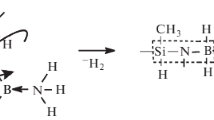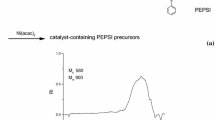Abstract
We report the synthesis of β-SiAlON:Eu2+ phosphors from novel single source precursors in which strictly controlled chemical composition is established at molecular scale. The two-step synthesis occurs by the chemical modification of perhydropolysilazane (PHPS) with Al(OCH(CH3)2)3 and AlCl3 in xylene at room temperature to 140 °C to introduce Al in the PHPS network while controlling the oxygen content followed by the reaction of EuCl2 with the Al-modified PHPS upon heat-treatment. Gas chromatography-mass spectrometry and thermogravimetry-mass spectrometry analyses revealed that PHPS reacted with Al(OCH(CH3)2)3 and AlCl3 via the formation of Al-N bonds. Moreover, AlCl3 reacted with nitrogen-bonded Al alkoxide residue to release 2-chloropropane in an analogy to the non-hydrolytic sol-gel reaction between metal alkoxide and metal chloride. Subsequently, AlCl3 acted as a Lewis acid catalyst to promote the Friedel-Craft alkylation between xylene solvent and the 2-chloropropane formed in-situ to afford dimethylcumene. On the other hand, EuCl2 reacted with silylamino moiety to form Eu-N bonds at around 850 °C. β-SiAlON:Eu2+ phosphors were successfully synthesized by pyrolysis of the precursors under flowing N2 or NH3 at 1000 °C, followed by heat treatment at 1800 °C for 1 h under a N2 gas pressure at 980 kPa. The polymer-derived β-SiAlON:Eu2+ (z = 0.55, Eu2+ 0.37 at%) exhibited green emission under excitation at 410 or 460 nm, and the green emission intensity under the excitation at 410 nm was found to be increased by reducing the carbon and chlorine impurities through the polymer-derived ceramics route investigated in this study.

Graphical abstract
Highlights
-
β-SiAlON:Eu2+ phosphors were synthesized from Al- and Eu-modified perhydropolysilazanes.
-
The modification using Al(OCH(CH3)2)3 with AlCl3 promoted non-hydrolytic sol-gel (NHSG) reaction.
-
The NHSG reaction and NH3-pyrolysis synergistically contributed to reducing C and Cl impurities.
-
The β-SiAlON:Eu2+ (z = 0.55, Eu2+ 0.37 at%) exhibited green emission (λex = 410 or 460 nm.
-
The green emission intensity (λex = 410 nm) was increased by reducing C and Cl impurities.






Similar content being viewed by others
References
Zhang C, Uchikoshi T, Xie RJ, Liu L, Sakka Y, Hirosaki N (2019) Significantly improved photoluminescence of the green‐emitting β‐sialon: Eu2+ phosphor via surface coating of TiO2. J Am Ceram Soc 102:294–302. https://doi.org/10.1111/jace.15909
Xie RJ, Hirosaki N (2007) Silicon‐based oxynitride and nitride phosphors for white LEDs‐A review. Sci Technol Adv Mater 8:588–600. https://doi.org/10.1016/j.stam.2007.08.005
Wang Z, Ye W, Chu IH, Ong SP (2016) Elucidating structure–composition–property relationships of the β-SiAlON:Eu2+ Phosphor. Chem Mater 28:8622–8630. https://doi.org/10.1021/acs.chemmater.6b03555
Xie RJ, Hirosaki N, Li HL, Li YQ, Mitomo M (2007) Synthesis and photoluminescence properties of β-sialon: Eu2+(Si6−zAlzOzN8−z:Eu2+: A promising green oxynitride phosphor for white light-emitting diodes. J Electrochem Soc 154:J314–J319 https://doi.org/10.1149/1.2768289
Takahashi K, Xie RJ, Hirosaki N (2011) Toward higher color purity and narrower emission band β-sialon: Eu2+ by reducing the oxygen concentration. ECS Solid State Lett 14:E38-E40. https://doi.org/10.1149/2.017111esl
Li S, Wang L, Tang DM, Cho YJ, Liu XJ, Zhou XT, Lu L, Zhang L, Takeda T, Hirosaki N, Xie RJ (2018) Achieving high quantum efficiency narrow-band β-Sialon:Eu2+ phosphors for high-brightness LCD backlights by reducing the Eu3+ luminescence killer. Chem Mater 30:494-505. https://doi.org/10.1021/acs.chemmater.7b04605
Clément S, Mehdi A (2020) Sol-Gel chemistry: From molecule to functional materials. Molecules 25:2538. https://doi.org/10.3390/molecules25112538
Sanchez C, Boissiere C, Cassaignon S, Chanéac C, Durupthy O, Faustini M, Grosso D, Laberty-Robert C, Nicole L, Portehault D, Ribot F, Rozes L, Sassoye C (2014) Molecular engineering of functional inorganic and hybrid materials. Chem Mater 26:221–238. https://doi.org/10.1021/cm402528b
Sanchez C, Rozes L, Ribot F, Laberty-Robert C, Grosso D, Sassoye C, Boissiere C, Nicole L (2010) “Chimie douce”: A land of opportunities for the designed construction of functional inorganic and hybrid organic-inorganic nanomaterials. C R Chim 13:3–39. https://doi.org/10.1016/j.crci.2009.06.001
Lale A, Schmidt M, Mallmann MD, Bezerra AVA, Acosta ED, Machado RAF, Demirci UB, Bernard S (2018) Polymer-Derived Ceramics with engineered mesoporosity: From design to application in catalysis. Surf Coat Technol 350:569–586. https://doi.org/10.1016/j.surfcoat.2018.07.061
Colombo P, Mera G, Riedel R, Soraru GD (2010) Polymer‐derived ceramics: 40 years of research and innovation in advanced ceramics. J Am Ceram Soc 93:1805–1837. https://doi.org/10.1111/j.1551-2916.2010.03876.x
Ionescu E, Kleebe HJ, Riedel R (2012) Silicon-containing polymer-derived ceramic nanocomposites (PDC-NCs): preparative approaches and properties. Chem Soc Rev 41:5032–5052. https://doi.org/10.1039/C2CS15319J
Iwamoto Y, Ionescu E, Bernard S (2021) Preceramic Polymers as Precursors of Advanced Ceramics: The Polymer-Derived Ceramics (PDCs) Route. In: Hampshire S, Leriche A (ed.) Encyclopedia of materials: Technical ceramics and glasses. Elsevier, Amsterdam.
Funayama O, Arai M, Tashiro Y, Aoki H, Suzuki T, Tamura K, Kaya H, Nishii H, Isoda T (1990) Tensile strength of silicon nitride fibers produced from perhydropolysilazane. J Ceram Soc JAPAN 98:104–107. https://doi.org/10.2109/jcersj.98.104
Blanchard CR, Schwab ST (1994) X‐ray diffraction analysis of the pyrolytic conversion of perhydropolysilazane into silicon nitride. J Am Ceram Soc 77:1729–1739. https://doi.org/10.1111/j.1151-2916.1994.tb07043.x
Iwamoto Y, Völger W, Kroke E, Riedel R, Saitou T, Matsunaga K (2001) Crystallization behavior of amorphous silicon carbonitride ceramics derived from organometallic precursors. J Am Ceram Soc 84:2170–2178. https://doi.org/10.1111/j.1151-2916.2001.tb00983.x
Funayama O, Kato T, Tashiro Y, Isoda T (1993) Synthesis of a polyborosilazane and its conversion into inorganic compounds. J Am Ceram Soc 76:717–723. https://doi.org/10.1111/j.1151-2916.1993.tb03665.x
Funayama O, Tashiro Y, Aoki T, Isoda T (1994) Synthesis and pyrolysis of polyaluminosilazane. J Ceram Soc JAPAN 102:908–912. https://doi.org/10.2109/jcersj.102.908
Gao Y, Iwasaki R, Hamana D, Iihama J, Honda S, Kumari M, Hayakawa T, Bernard S, Thomas P, Iwamoto Y (2022) Green emitting β-SiAlON:Eu2+ phosphors derived from chemically modified perhydropolysilazanes. Int J Appl Ceram Technol. (under review)
Iwamoto Y, Matsubara H, Brook R (1995) Microstructure development of Si3N4 ceramics derived from polymer precursor. In: Hausner H, Messing GL, Hirano S (ed.) Ceramic Processing Science and Technology, The American Ceramic Society, Westerville.
Iwamoto Y, Kikuta K, Hirano S (1998) Microstructural development of Si3N4–SiC–Y2O3 ceramics derived from polymeric precursors. J Mater Res 13:353–361. https://doi.org/10.1557/JMR.1998.0047
Iwamoto Y, Kikuta K, Hirano S (1999) Si3N4–SiC–Y2O3 ceramics derived from yttrium-modified block copolymer of perhydropolysilazane and hydroxy-polycarbosilane. J Mater Res 14:1886–1895. https://doi.org/10.1557/JMR.1999.0253
Iwamoto Y, Kikuta K, Hirano S (1999) Si3N4–TiN–Y2O3 ceramics derived from chemically modified perhydropolysilazane. J Mater Res 14:4294–4301. https://doi.org/10.1557/JMR.1999.0582
Tada S, Mallmann MD, Takagi H, Iihama J, Asakuma N, Asaka T, Daiko Y, Honda S, Nishihora RK, Machado RAF, Bernard S, Iwamoto Y (2021) Low temperature in situ formation of cobalt in silicon nitride toward functional nitride nanocomposites. Chem Commun 16:2057–2060. https://doi.org/10.1039/D0CC07366K
Asakuma N, Tada S, Kawaguchi E, Terashima M, Honda S, Nshihora RK, Carles P, Bernard S, Iwamoto Y (2022) Mechanistic investigation of the formation of nickel nano-crystallites embedded in amorphous silicon nitride nanocomposites. Nanomaterials 12:1644. https://doi.org/10.3390/nano12101644
Iwamoto Y, Kikuta K, Hirano S (2000) Synthesis of poly-titanosilazanes and conversion into Si3N4-TiN ceramics. J Ceram Soc JAPAN 108:350–356. https://doi.org/10.2109/jcersj.108.1256_350
Iwamoto Y, Kikuta K, Hirano S (2000) Crystallization and microstructure development of Si3N4-Ti(C, N)-Y2O3 ceramics derived from chemically modified perhydropolysilazane. J Ceram Soc JAPAN 108:1072–1078. https://doi.org/10.2109/jcersj.108.1264_1072
Lale A, Mallmann MD, Tada S, Bruma A, Özkar S, Kumar R, Haneda M, Machado RAF, Iwamoto Y, Demirci UB, Bernard S (2020) Highly active, robust and reusable micro-/mesoporous TiN/Si3N4 nanocomposite-based catalysts for clean energy: Understanding the key role of TiN nanoclusters and amorphous Si3N4 matrix in the performance of the catalyst system. Appl Catal B 272:118975. https://doi.org/10.1016/j.apcatb.2020.118975
Funayama O, Aoki T, Isoda T (1996) Synthesis and pyrolysis of polyborosilazane with low oxygen content. J Ceram Soc JAPAN 104:355–360. https://doi.org/10.2109/jcersj.104.355
Gazzara CP, Messier DR (1977) Determination of phase content of Si3N4 by X-Ray diffraction analysis. Ceram Bull 56:777–780. https://bulletin-archive.ceramics.org/1977-09/
Christensen PA, Mashhadani ZTAW, Abd Halim Bin Md Ali, Carroll MA, Martin PA (2018) The production of methane, acetone, “Cold” CO and oxygenated species from isopropyl alcohol in a Non-thermal plasma: An in-situ FTIR study. J Phys Chem A 122:4273–4284. https://doi.org/10.1021/acs.jpca.7b12297
Park SY, Kim N, Kim UY, Hong SI, Sasabe H (1990) Plasma polymerization of hexamethyldisilazane. Polym J 22:242–249. https://doi.org/10.1295/polymj.22.242
NIST Chemistry WebBook - SRD 69 (2017) National Institute of Standards and Technology, Gaithersburg. https://webbook.nist.gov/chemistry. Accessed 23 May 2022.
Vioux A, Mutin PH (2018) In: Klein L, Aparicio M, Jitianu A (ed) Handbook of Sol-Gel Science and Technology, Springe Nature Group, Berlin. https://doi.org/10.1007/978-3-319-32101-1
Acosta S, Corriu RJP, Leclercq D, Lefèvre P, Mutin PH, Vioux A (1994) Preparation of alumina gels by a non-hydrolytic sol-gel processing method. J Non Cryst Solids 170:234–242. https://doi.org/10.1016/0022-3093(94)90052-3
Vioux A (1997) Nonhydrolytic sol-gel routes to oxides. Chem Mater 9:2292–2299. https://doi.org/10.1021/cm970322a
Whalley P (2016) The comparison of Friedel-Crafts alkylation and acylation as a means to synthesise alkyl xylenes. The Plymouth Student. Scientist 9:252–296. http://hdl.handle.net/10026.1/14124
Weimer AW, Eisman GA, Sunsnitzky DW, Beaman DR, McCoy JW (1997) Mechanism and kinetics of the carbothermal nitridation synthesis of α-Silicon Nitride. J Am Ceram Soc 80:2853–2863. https://doi.org/10.1111/j.1151-2916.1997.tb03203.x
Ekström T, Nygren M (1992) SiAION Ceramics. J Am Ceram Soc 75:259–276. https://doi.org/10.1111/j.1151-2916.1992.tb08175.x
Zhou Y, Yoshizawa Y, Hirao K, Lenčéš Z, Šajgalik P (2008) Preparation of Eu-doped β-SiAlON phosphors by combustion synthesis. J Am Ceram Soc 91:3082–3085. https://doi.org/10.1111/j.1551-2916.2008.02531.x
Kimoto K, Xie RJ, Matsui Y, Ishizuka K, Hirosaki N (2009) Direct observation of single dopant atom in light-emitting phosphor of β-SiAlON:Eu2+. Appl Phys Lett 94:041908. https://doi.org/10.1063/1.3076110
Acknowledgements
Dr. Samuel Bernard, Dr. Philippe Thomas and Prof. Yuji Iwamoto would like to thank CNRS who financially supported the present work via the International Research Project (IRP) ‘Ceramics materials for societal challenges’. Mr. Daiki Hamana, Mr. Ryo Iwasaki, and Mr. Junya Iihama would like to thank the Nagoya Institute of Technology (NITech) who financially supported their present research work via the ‘NITech for Global Initiative Projects’.
Author contributions
All authors contributed to the study conception and design. YG conceived and planned this study, and drafted the manuscript; YG, DH, RI, JI, and MK contributed to the evaluation of samples; SH and TH contributed to Formal analysis; PT and SB reviewed the draft; Yuji Iwamoto conceived, reviewed, and supervised this work. The first draft of the manuscript was written by YG and all authors commented on previous versions of the manuscript. All authors read and approved the final manuscript.
Funding
This work was supported by Japan Science and Technology Agency (JST) SPRING, Grant Number JPMJSP 2112.
Author information
Authors and Affiliations
Corresponding author
Ethics declarations
Conflict of interest
The authors declare no competing interests.
Additional information
Publisher’s note Springer Nature remains neutral with regard to jurisdictional claims in published maps and institutional affiliations.
Rights and permissions
About this article
Cite this article
Gao, Y., Hamana, D., Iwasaki, R. et al. Chemical route for synthesis of β-SiAlON:Eu2+ phosphors combining polymer-derived ceramics route with non-hydrolytic sol-gel chemistry. J Sol-Gel Sci Technol 104, 711–723 (2022). https://doi.org/10.1007/s10971-022-05879-w
Received:
Accepted:
Published:
Issue Date:
DOI: https://doi.org/10.1007/s10971-022-05879-w




